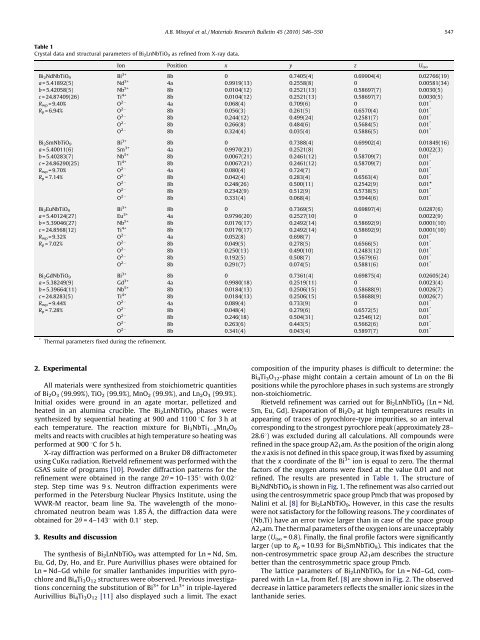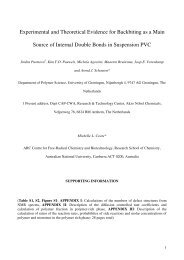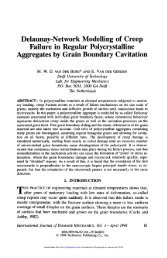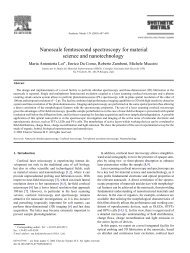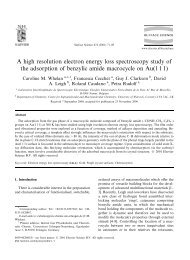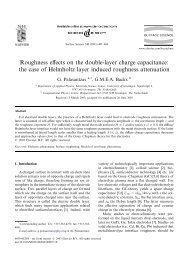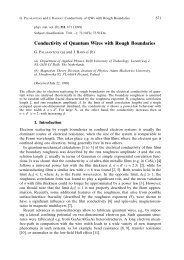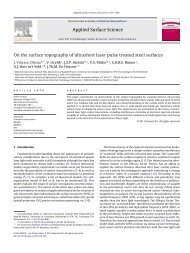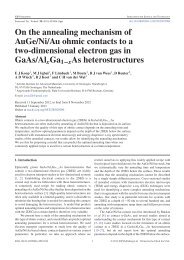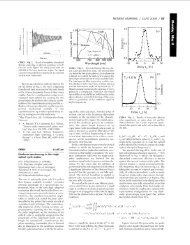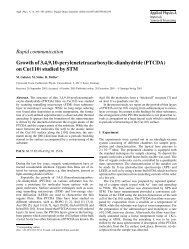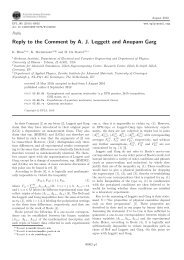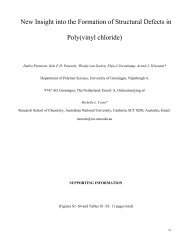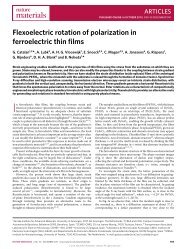Double-layered Aurivillius-type ferroelectrics with magnetic moments
Double-layered Aurivillius-type ferroelectrics with magnetic moments
Double-layered Aurivillius-type ferroelectrics with magnetic moments
You also want an ePaper? Increase the reach of your titles
YUMPU automatically turns print PDFs into web optimized ePapers that Google loves.
A.B. Missyul et al. / Materials Research Bulletin 45 (2010) 546–550 547<br />
Table 1<br />
Crystal data and structural parameters of Bi 2 LnNbTiO 9 as refined from X-ray data.<br />
Ion Position x y z U iso<br />
Bi 2 NdNbTiO 9 Bi 3+ 8b 0 0.7405(4) 0.69904(4) 0.02766(19)<br />
a = 5.41892(5) Nd 3+ 4a 0.9919(13) 0.2558(8) 0 0.00581(34)<br />
b = 5.42058(5) Nb 5+ 8b 0.0104(12) 0.2521(13) 0.58697(7) 0.0030(5)<br />
c = 24.87409(26) Ti 4+ 8b 0.0104(12) 0.2521(13) 0.58697(7) 0.0030(5)<br />
R wp = 9.40% O 2 4a 0.068(4) 0.709(6) 0 0.01 *<br />
R p = 6.94% O 2 8b 0.056(3) 0.261(5) 0.6570(4) 0.01 *<br />
O 2 8b 0.244(12) 0.499(24) 0.2581(7) 0.01 *<br />
O 2 8b 0.266(8) 0.484(6) 0.5684(5) 0.01 *<br />
O 2 8b 0.324(4) 0.035(4) 0.5886(5) 0.01 *<br />
Bi 2 SmNbTiO 9 Bi 3+ 8b 0 0.7388(4) 0.69902(4) 0.01849(16)<br />
a = 5.40011(6) Sm 3+ 4a 0.9970(23) 0.2521(8) 0 0.0022(3)<br />
b = 5.40283(7) Nb 5+ 8b 0.0067(21) 0.2461(12) 0.58709(7) 0.01 *<br />
c = 24.86290(25) Ti 4+ 8b 0.0067(21) 0.2461(12) 0.58709(7) 0.01 *<br />
R wp = 9.70% O 2 4a 0.080(4) 0.724(7) 0 0.01 *<br />
R p = 7.14% O 2 8b 0.042(4) 0.283(4) 0.6563(4) 0.01 *<br />
O 2 8b 0.248(26) 0.500(11) 0.2542(9) 0.01*<br />
O 2 8b 0.2342(9) 0.512(9) 0.5738(5) 0.01 *<br />
O 2 8b 0.331(4) 0.068(4) 0.5944(6) 0.01 *<br />
Bi 2 EuNbTiO 9 Bi 3+ 8b 0 0.7369(5) 0.69897(4) 0.0287(6)<br />
a = 5.40124(27) Eu 3+ 4a 0.9796(20) 0.2527(10) 0 0.0022(9)<br />
b = 5.39046(27) Nb 5+ 8b 0.0176(17) 0.2492(14) 0.58692(9) 0.0001(10)<br />
c = 24.8568(12) Ti 4+ 8b 0.0176(17) 0.2492(14) 0.58692(9) 0.0001(10)<br />
R wp = 9.32% O 2 4a 0.052(8) 0.698(7) 0 0.01 *<br />
R p = 7.02% O 2 8b 0.049(5) 0.278(5) 0.6566(5) 0.01 *<br />
O 2 8b 0.250(13) 0.490(10) 0.2483(12) 0.01 *<br />
O 2 8b 0.192(5) 0.508(7) 0.5679(6) 0.01 *<br />
O 2 8b 0.291(7) 0.074(5) 0.5881(6) 0.01 *<br />
Bi 2 GdNbTiO 9 Bi 3+ 8b 0 0.7361(4) 0.69875(4) 0.02605(24)<br />
a = 5.38249(9) Gd 3+ 4a 0.9980(18) 0.2519(11) 0 0.0023(4)<br />
b = 5.39664(11) Nb 5+ 8b 0.0184(13) 0.2506(15) 0.58688(9) 0.0026(7)<br />
c = 24.8283(5) Ti 4+ 8b 0.0184(13) 0.2506(15) 0.58688(9) 0.0026(7)<br />
R wp = 9.44% O 2 4a 0.089(4) 0.733(9) 0 0.01 *<br />
R p = 7.28% O 2 8b 0.048(4) 0.279(6) 0.6572(5) 0.01 *<br />
O 2 8b 0.246(18) 0.504(31) 0.2546(12) 0.01 *<br />
O 2 8b 0.263(6) 0.443(5) 0.5662(6) 0.01 *<br />
O 2 8b 0.341(4) 0.043(4) 0.5897(7) 0.01 *<br />
* Thermal parameters fixed during the refinement.<br />
2. Experimental<br />
All materials were synthesized from stoichiometric quantities<br />
of Bi 2 O 3 (99.99%), TiO 2 (99.9%), MnO 2 (99.9%), and Ln 2 O 3 (99.9%).<br />
Initial oxides were ground in an agate mortar, pelletized and<br />
heated in an alumina crucible. The Bi 2 LnNbTiO 9 phases were<br />
synthesized by sequential heating at 900 and 1100 8C for 3 h at<br />
each temperature. The reaction mixture for Bi 3 NbTi 1 x Mn x O 9<br />
melts and reacts <strong>with</strong> crucibles at high temperature so heating was<br />
performed at 900 8C for 5 h.<br />
X-ray diffraction was performed on a Bruker D8 diffractometer<br />
using CuKa radiation. Rietveld refinement was performed <strong>with</strong> the<br />
GSAS suite of programs [10]. Powder diffraction patterns for the<br />
refinement were obtained in the range 2u = 10–1358 <strong>with</strong> 0.028<br />
step. Step time was 9 s. Neutron diffraction experiments were<br />
performed in the Petersburg Nuclear Physics Institute, using the<br />
WWR-M reactor, beam line 9a. The wavelength of the monochromated<br />
neutron beam was 1.85 Å, the diffraction data were<br />
obtained for 2u = 4–1438 <strong>with</strong> 0.18 step.<br />
3. Results and discussion<br />
The synthesis of Bi 2 LnNbTiO 9 was attempted for Ln = Nd, Sm,<br />
Eu, Gd, Dy, Ho, and Er. Pure <strong>Aurivillius</strong> phases were obtained for<br />
Ln = Nd–Gd while for smaller lanthanides impurities <strong>with</strong> pyrochlore<br />
and Bi 4 Ti 3 O 12 structures were observed. Previous investigations<br />
concerning the substitution of Bi 3+ for Ln 3+ in triple-<strong>layered</strong><br />
<strong>Aurivillius</strong> Bi 4 Ti 3 O 12 [11] also displayed such a limit. The exact<br />
composition of the impurity phases is difficult to determine: the<br />
Bi 4 Ti 3 O 12 -phase might contain a certain amount of Ln on the Bi<br />
positions while the pyrochlore phases in such systems are strongly<br />
non-stoichiometric.<br />
Rietveld refinement was carried out for Bi 2 LnNbTiO 9 (Ln = Nd,<br />
Sm, Eu, Gd). Evaporation of Bi 2 O 3 at high temperatures results in<br />
appearing of traces of pyrochlore-<strong>type</strong> impurities, so an interval<br />
corresponding to the strongest pyrochlore peak (approximately 28–<br />
28.68) was excluded during all calculations. All compounds were<br />
refined in the space group A2 1 am. As the position of the origin along<br />
the x axis is not defined in this space group, it was fixed by assuming<br />
that the x coordinate of the Bi 3+ ion is equal to zero. The thermal<br />
factors of the oxygen atoms were fixed at the value 0.01 and not<br />
refined. The results are presented in Table 1. The structure of<br />
Bi 2 NdNbTiO 9 is shown in Fig. 1. The refinement was also carried out<br />
using the centrosymmetric space group Pmcb that was proposed by<br />
Nalini et al. [8] for Bi 2 LaNbTiO 9 . However, in this case the results<br />
were not satisfactory for the following reasons. The y coordinates of<br />
(Nb,Ti) have an error twice larger than in case of the space group<br />
A2 1 am. The thermal parameters of the oxygen ions are unacceptably<br />
large (U iso = 0.8). Finally, the final profile factors were significantly<br />
larger (up to R p = 10.93 for Bi 2 SmNbTiO 9 ). This indicates that the<br />
non-centrosymmetric space group A2 1 am describes the structure<br />
better than the centrosymmetric space group Pmcb.<br />
The lattice parameters of Bi 2 LnNbTiO 9 for Ln = Nd–Gd, compared<br />
<strong>with</strong> Ln = La, from Ref. [8] are shown in Fig. 2. The observed<br />
decrease in lattice parameters reflects the smaller ionic sizes in the<br />
lanthanide series.


